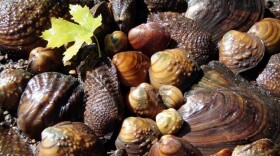By the time this airs, I will be the proud owner of a new hip. And although this might seem rather random, it brings me to this month’s Field Notes about horseshoe crabs and red knots.
I grew up on the east coast with frequent trips to Cape Cod where horseshoe crabs were common on the shore. They are one of the strangest critters ever; they are ancient animals who have been on earth for 450 million years and have scarcely changed in all that time. Although they have no backbone they have a hard exoskeleton in the form of a helmet-like carapace covering their body and may be up to 2 feet long. They have ten legs, each with a set of pincers with one pair of legs near their mouth for crunching food. Their stiff tail, the telson, is handy in helping them flip over when they find themselves belly-side up. They have ten eyes, including two compound eyes for forming images and eight simple eyes that act as light sensors, telling them when it is day or night. They are not true crabs but are actually more closely related to spiders and scorpions. They don’t sting or bite but they must come to shore to breed, which is where they get into trouble.
Probably the weirdest feature of these fantastic creatures is their blood. It is blue! And it is blue because it has a special copper-containing compound called hemocyanin. The copper element at the center of the hemocyanin binds with and carries oxygen throughout the body of the horseshoe crab, just as the iron atoms in our hemoglobin binds to and carries oxygen through our bodies. When our blood is exposed to air, it turns red, and when hemocyanin is exposed to the air it turns blue.
But the real special sauce in this blue blood is a copper-containing protein, called Limulus Amebocyte Lysate or LAL. This compound clots when it encounters any endotoxins, chemicals found on the outer membrane of certain bacteria responsible for fevers, septic shock and other ailments. Once this was discovered, pharmaceutical and medical device companies devised methods to use the horseshoe crab blood to test for and detect contamination in their products. Now, technicians extract horseshoe crabs’ blood, and it is big business to supply this blood for medical needs. The horseshoe crabs are not intentionally killed during this bloodletting, though probably something like 5-20 or maybe up to 30% of the animals do die during the process. The animals are treated roughly, but since they are not vertebrates, there are few hard laws on how they must be treated. Unfortunately, this isn’t the only abuse of horseshoe crabs; they are also used as bait in the eel and conch fishery along the east coast.
Another complication of the horseshoe crab story involves red knots, a kind of sandpiper that makes an epic migration every year, from South America to the Arctic and back. These sand pipers are completely dependent on gorging on horseshoe crab eggs as they make a pitstop on the East Coast of the US midway through their trip south from the Arctic. With so many horseshoe crabs being removed for the medical industry or used for bait, numbers of horseshoe crabs and red knots are both plummeting. The red knots are so badly affected by the diminished numbers of horseshoe crab eggs that they are now endangered. There are some conservation efforts, including by the US Fish and Wildlife Service, to help preserve the red knot and horseshoe crab populations.
A possible bright spot in this complicated story is that there is now a synthetic version of LAL, the compound that clots in the presence of endotoxins. But while European medical providers are now using this synthetic LAL, it is still not approved for use in the US. It seems that the industries involved in horseshoe crab blood collection and medical testing are content to continue this practice that has worked for many years, with little incentive to change practices.
I suppose horseshoe crab blood was also used to make sure my new hip was clean and sanitized, which makes me grateful, but also rather sad. Hopefully, with careful management of the critters, and maybe eventual use of the synthetic LAL, the future of horseshoe crabs will be as long and successful as their past.
Thanks to the public radio station WNYC’s Radiolab for introducing me to this story.









